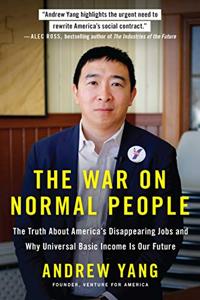
Want to learn the ideas in The War On Normal People better than ever? Read the world’s #1 book summary of The War On Normal People by Andrew Yang here.
Read a brief 1-Page Summary or watch video summaries curated by our expert team. Note: this book guide is not affiliated with or endorsed by the publisher or author, and we always encourage you to purchase and read the full book.
Video Summaries of The War On Normal People
We’ve scoured the Internet for the very best videos on The War On Normal People, from high-quality videos summaries to interviews or commentary by Andrew Yang.
1-Page Summary of The War On Normal People
Overview
The founder of Venture for America, Andrew Yang, often traveled to cities like Baltimore, Detroit and New Orleans. He noticed that despite the fact that these people were facing major difficulties accessing healthcare and education, many communities were struggling with issues related to drug addiction. On top of this, he realized that our economy is on the brink of a mass unemployment crisis driven by unprecedented technological advances.
In this article, you’ll learn about the challenges Americans are facing today and how to fix them. You’ll find out why Richard Nixon’s plan for a guaranteed income failed in the 1970s; why empty malls lead to broken cities; and how capitalism is better when it values humans.
Big Idea #1: Advances in technology and market-driven capitalism have left America on the brink of mass unemployment.
Think about your five closest friends. If they all went to college, then you’re part of a privileged socioeconomic group in the U.S., as most people don’t finish college.
In contrast to the educated class, average Americans tend to live paycheck-to-paycheck. Our capitalist system has given us technology like smartphones, but it doesn’t value most people’s lives. Instead, it values efficiency and cost cutting measures that make the market perform better.
According to Yang, the future is bleak. Technology will eliminate millions of jobs and make it difficult for people to find work. The US labor force participation rate is lower than most industrialized countries because many workers can’t find jobs.
Yang predicts that automation will be a big issue in the future. He calls this phenomenon the Great Displacement, and unlike many economic situations, it isn’t something that can be solved by the market. According to a report published by Obama’s administration in 2016, 83 percent of jobs that pay less than $20 per hour could face automation or replacement.
Automation has displaced many workers in the past few years. It is projected to eliminate millions of jobs in the next decade or so. Many factory jobs, cashier jobs, customer service representative positions and fast-food chain employee roles will be eliminated by automation.
Technology has made it possible to automate many jobs. Even if all white-collar workers are forced to find new work in the future, low income earners without a college degree will be left behind because they don’t have any other skills that can help them get a job in today’s world.
Big Idea #2: Job losses lead to broken cities, broken communities, and broken families.
In order to address the problem of unemployment, many economists are looking back at the Industrial Revolution for answers. They claim that in the future economy – which we can’t even imagine yet – new jobs will materialize just as they did during the Industrial Revolution. This overlooks how much more sophisticated today’s technologies are compared to those used during the Industrial Revolution and also disregards how turbulent that period was for society.
About one in ten American workers who earn an average income of $11 per hour are sales and retail workers. This is largely due to e-commerce giants like Amazon, which are taking away customers from brick and mortar stores. In addition, the growing prevalence of self-service checkout scanners is making it easier for people to buy things online without needing to interact with a salesperson at all. As a result, mall anchor stores such as Macy’s have been closing locations while chains like Payless Shoesource and Aeropostale have declared bankruptcy, forcing dozens of malls to close their doors.





